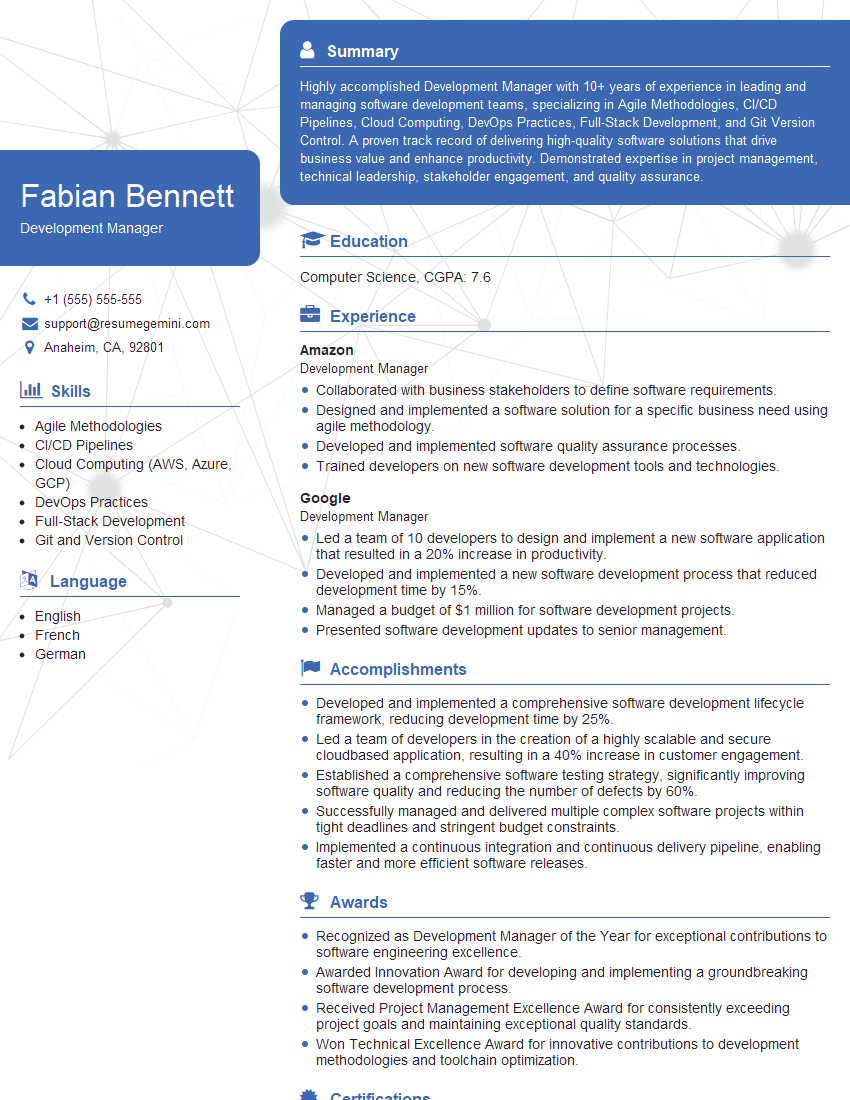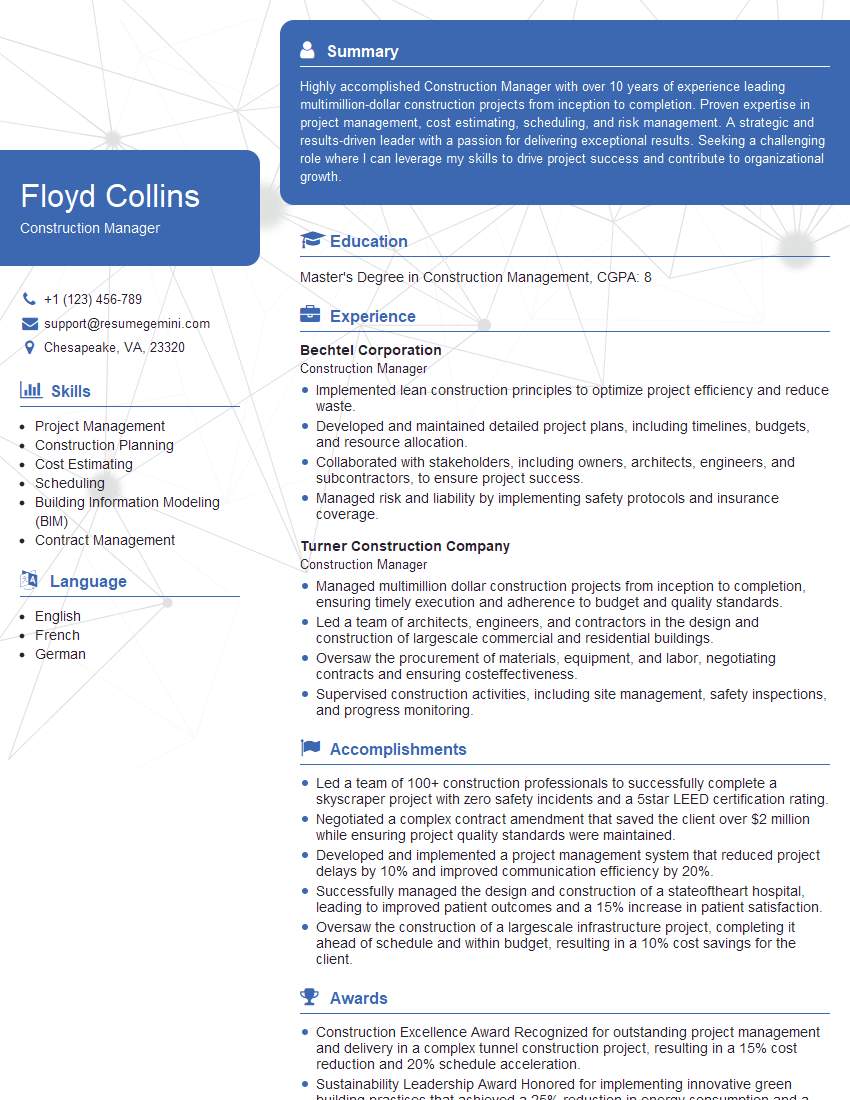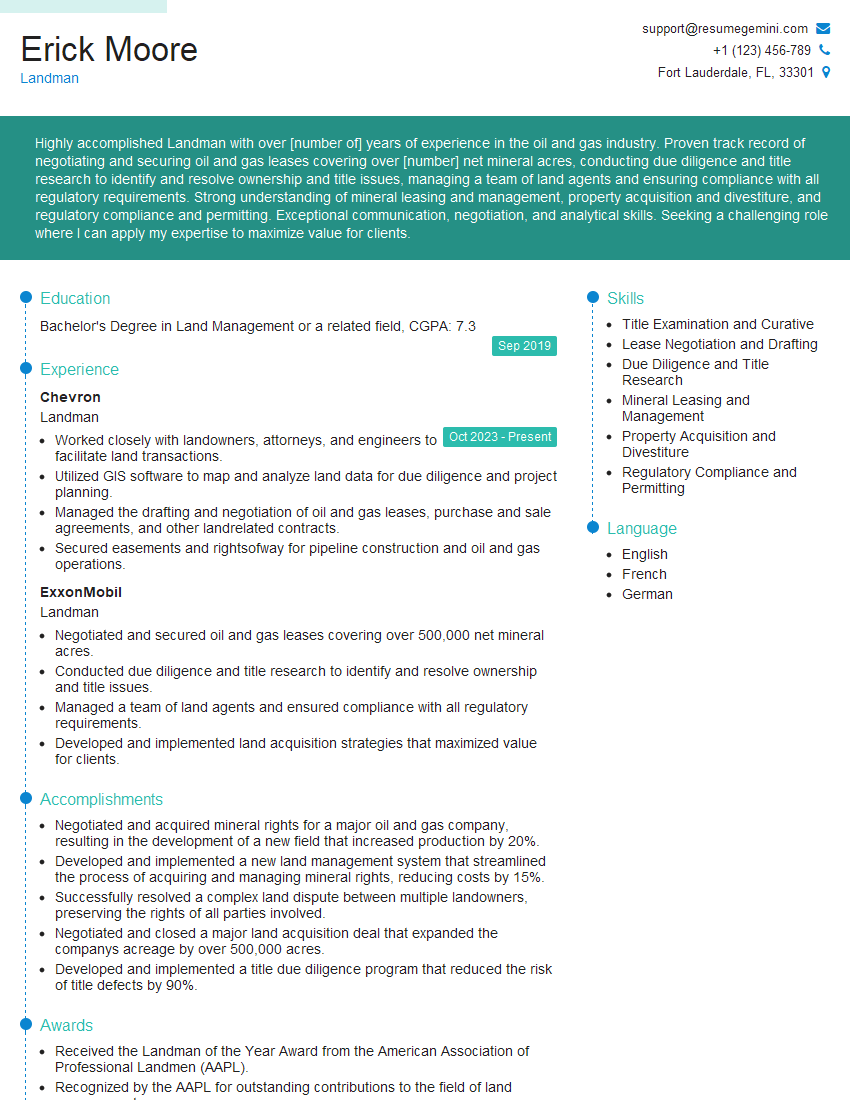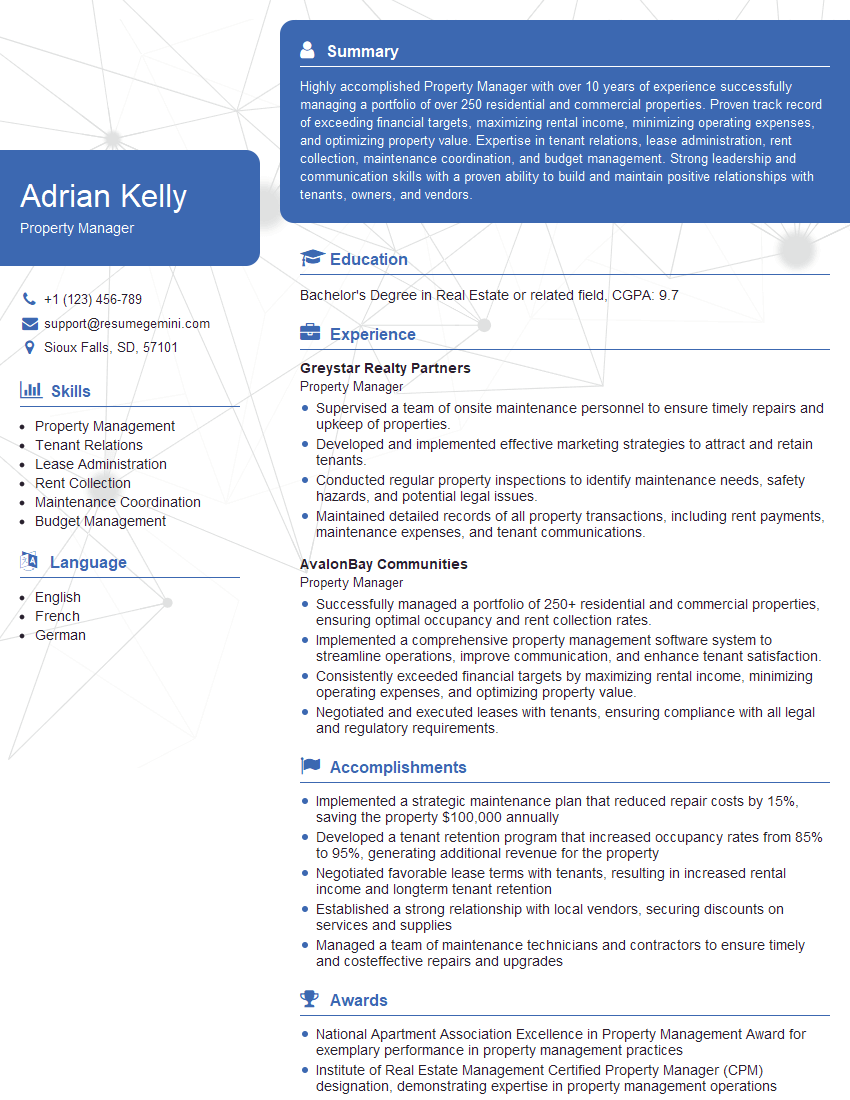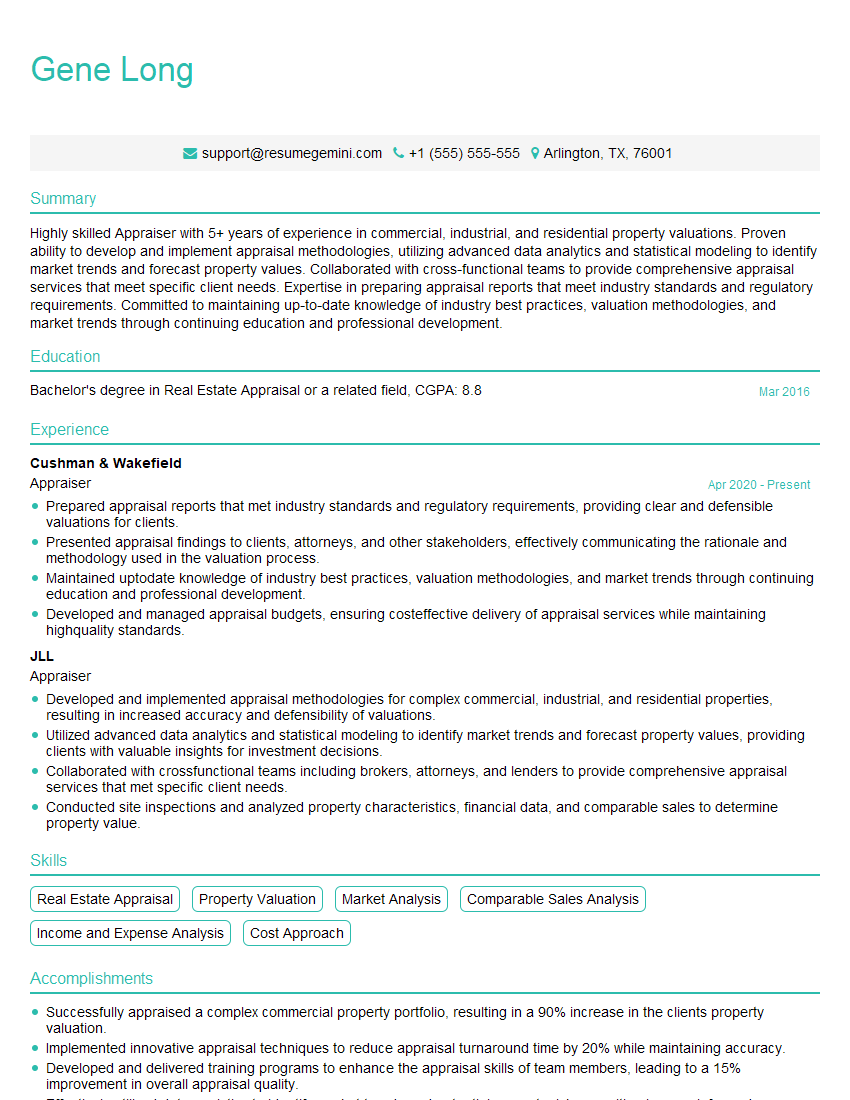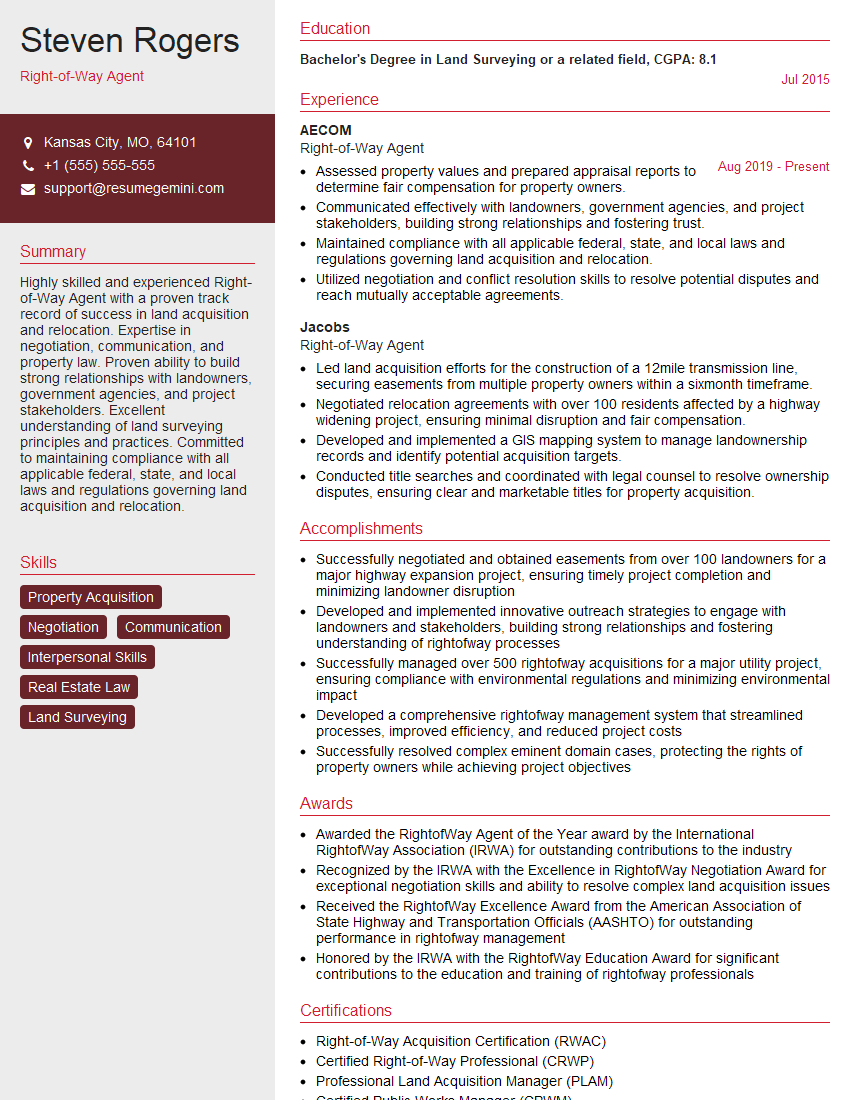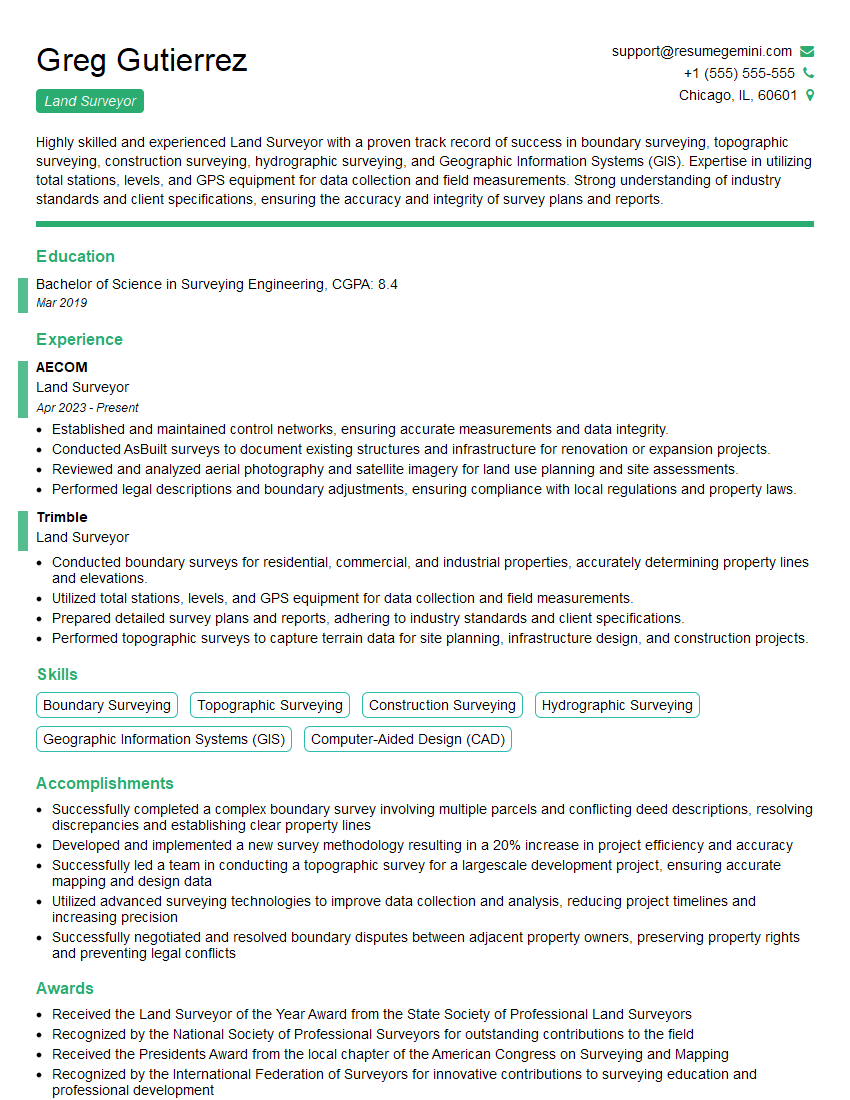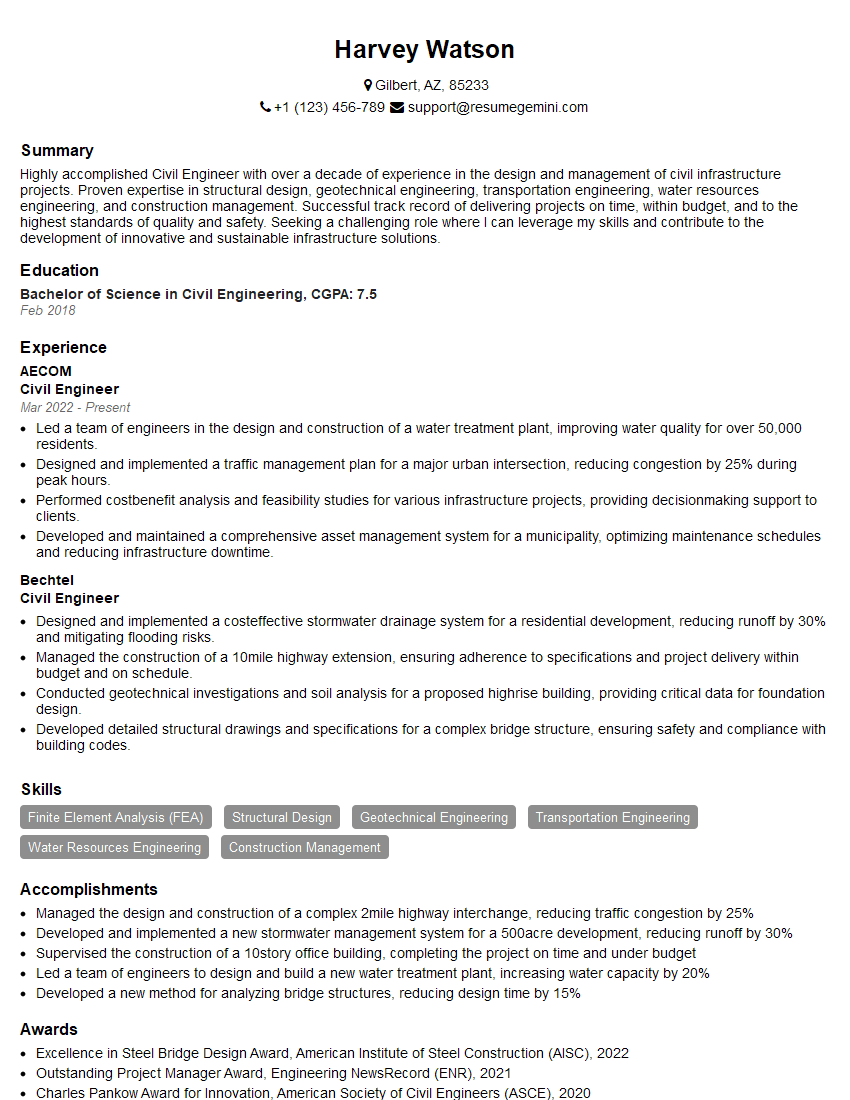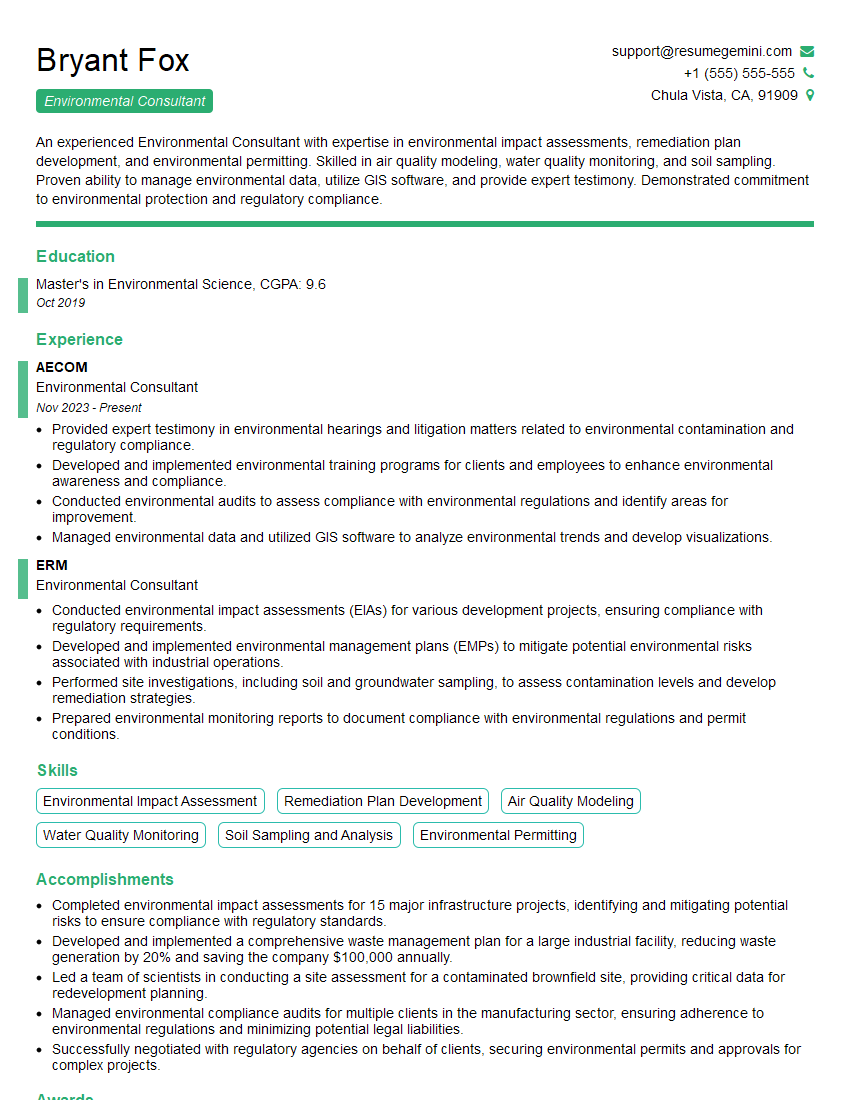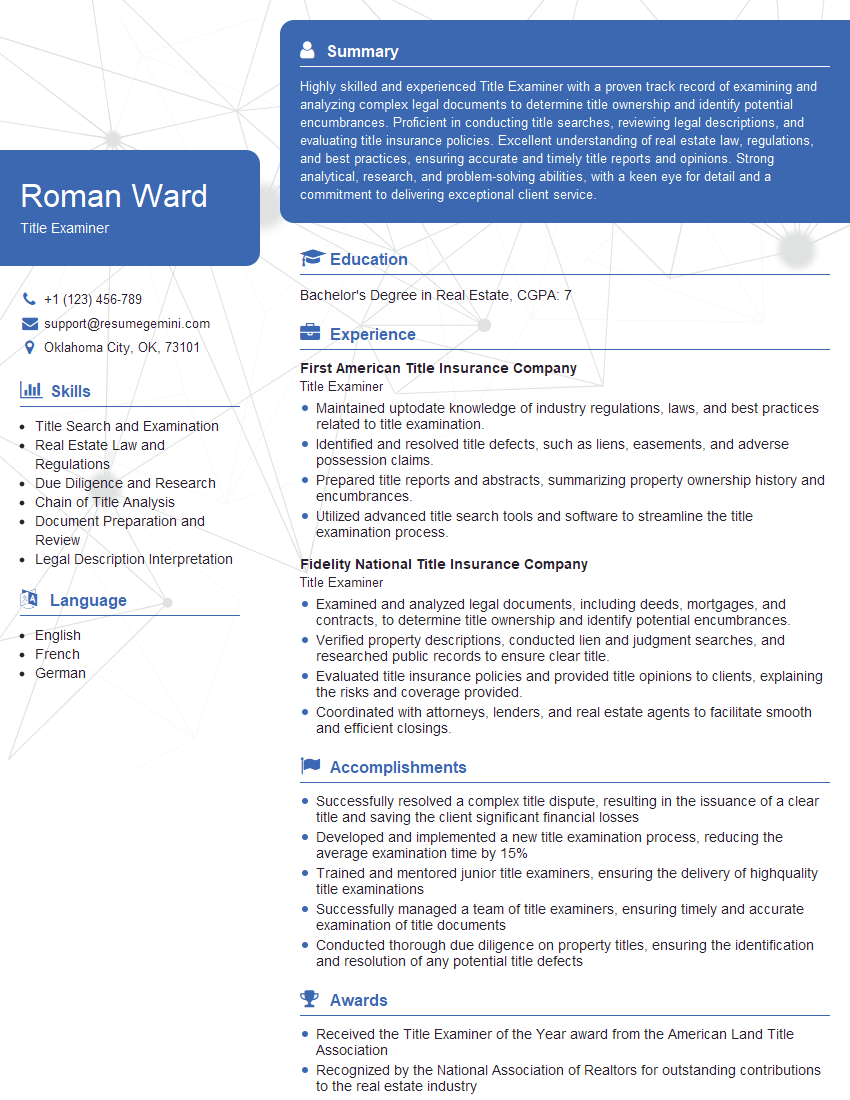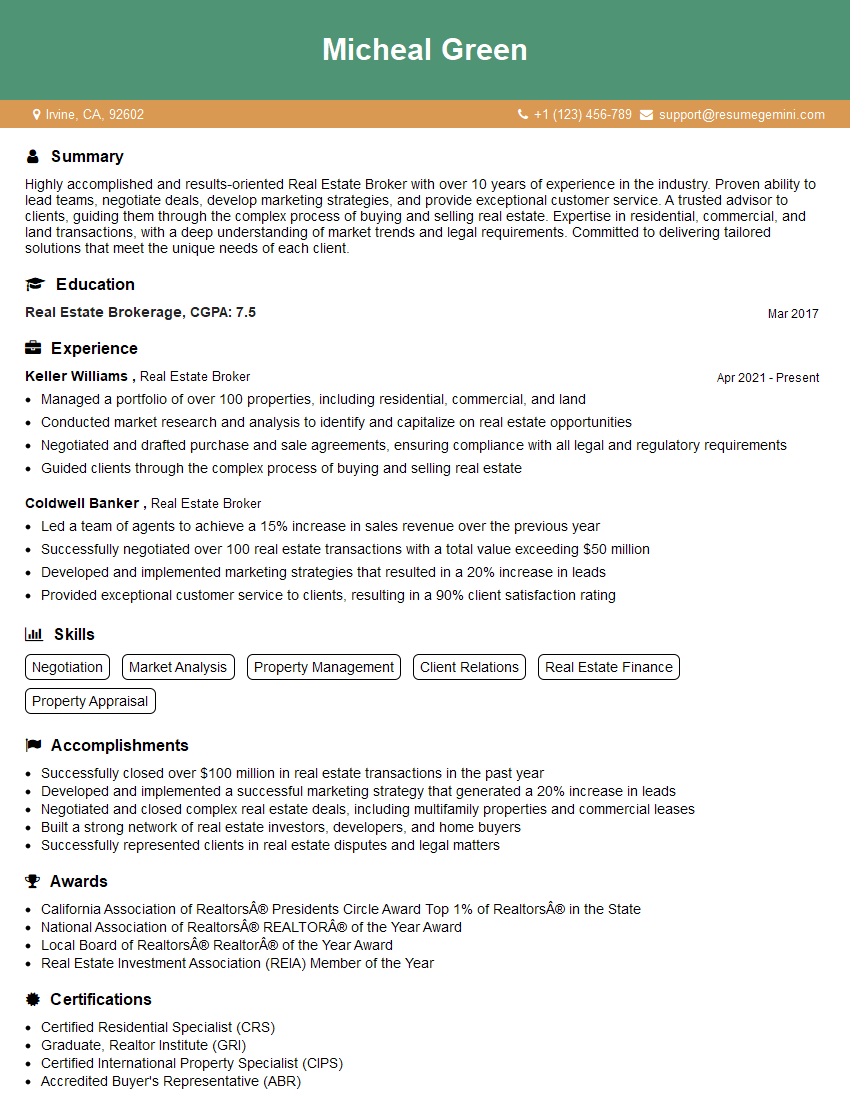Interviews are opportunities to demonstrate your expertise, and this guide is here to help you shine. Explore the essential Knowledge of legal descriptions and property boundaries interview questions that employers frequently ask, paired with strategies for crafting responses that set you apart from the competition.
Questions Asked in Knowledge of legal descriptions and property boundaries Interview
Q 1. Explain the difference between metes and bounds and lot and block descriptions.
Metes and bounds and lot and block descriptions are two fundamentally different ways to describe the boundaries of a parcel of land. Think of them as two distinct languages used to describe the same thing – location.
Metes and bounds descriptions use a series of directions and distances (metes) to define the perimeter of a property, often starting and ending at a clearly defined point of beginning (POB). Imagine walking around the property following precise instructions: ‘Start at the oak tree, then go north 100 feet, then west 50 feet, then south 100 feet, and finally east 50 feet to the point of beginning.’ This method is commonly used in areas surveyed before the widespread adoption of rectangular surveys.
Lot and block descriptions, on the other hand, refer to a recorded plat map. The plat map divides a larger area into smaller lots, each assigned a unique lot number and block number. The legal description simply states the lot and block number, referring you to the plat for the precise boundaries. Think of it like an address: ‘Lot 12, Block 3, Sunny Acres Subdivision’. This is a more concise method, especially in developed areas where plat maps are readily available.
The key difference lies in the level of detail and the method of referencing. Metes and bounds are more detailed and rely on direct measurements; lot and block are simpler and rely on referencing a recorded plat.
Q 2. What are some common sources of error in legal descriptions?
Errors in legal descriptions can have significant consequences, leading to boundary disputes and costly litigation. Common sources of error include:
- Ambiguous wording: Vague descriptions like ‘more or less’ or imprecise references to natural monuments (‘near the old oak tree’) can lead to interpretation issues.
- Incorrect measurements or calculations: Simple mistakes in surveying or transcription can significantly alter the property’s boundaries.
- Missing or misplaced monuments: If the original markers (e.g., iron pins, stones) are lost or moved, it becomes difficult to accurately establish the boundaries.
- Typographical errors: Simple typos in the legal description can lead to completely different boundaries.
- Outdated data: Descriptions written long ago might not reflect current conditions, especially in areas that have experienced significant development or erosion.
- Incorrect interpretation of calls: Misunderstanding directions, angles, or distances can result in errors.
Careful review and professional surveying are crucial to minimize these errors and ensure accurate property descriptions.
Q 3. How do you interpret a legal description containing bearings and distances?
Bearings and distances are the core components of metes and bounds descriptions. A bearing indicates the direction, typically expressed as an angle from north or south, while the distance is the length of the line segment. For example, ‘N 0°00′ E 100 ft’ means ‘go 100 feet in a direction 0 degrees east of north (due north).’
To interpret these, you need to visualize the property’s shape by plotting each bearing and distance sequentially. You’ll typically use a compass or protractor, and a scale to draw a map, creating the boundary lines. Imagine each bearing as an arrow and the distance as the length of that arrow. By connecting these arrows, you create a polygon representing the property boundaries.
It’s essential to understand that the order of calls (bearings and distances) is crucial. A change in order changes the resulting shape. Professional software and experienced surveyors use advanced techniques to analyze and interpret these descriptions precisely.
Q 4. Describe the process of researching and verifying property boundaries.
Researching and verifying property boundaries involves a multi-step process that combines historical research with on-site investigation. The steps typically include:
- Review existing documents: Start by examining the deed, plat maps, prior surveys, and any other relevant documents associated with the property. This helps establish the initial legal description and any historical boundary information.
- Conduct a title search: A title search reveals the chain of ownership and any recorded boundary disputes or easements affecting the property.
- Field examination: Visit the property and inspect visible evidence of boundaries, such as fences, walls, and monuments. Note any discrepancies between the documented description and what exists on the ground.
- Surveyor consultation: Consult with a licensed surveyor to conduct a boundary survey. The surveyor uses advanced equipment (GPS, total stations) to accurately locate the property boundaries and resolve any ambiguities or discrepancies. They’ll often prepare a new survey map.
- Document findings: Record all findings, including the results of the research, field examination, and survey, in a comprehensive report. This report serves as the definitive record of the property boundaries.
This thorough process minimizes the risk of boundary disputes and ensures the accurate representation of property ownership.
Q 5. What are the different types of surveys used to establish property boundaries?
Several types of surveys are employed to establish property boundaries, each serving a specific purpose:
- Boundary Survey: This is the most common type, aimed at determining the precise location of property lines. It often involves researching historical records and conducting fieldwork to identify existing markers or establish new ones.
- ALTA/ACSM Land Title Survey: This survey is more comprehensive than a standard boundary survey. It provides detailed information for title insurance companies, including easements, encroachments, and other pertinent details.
- Topographic Survey: This survey maps the land’s surface features, including elevation changes, which are essential for planning construction projects or assessing potential hazards.
- Construction Survey: This type of survey is crucial for construction projects. It provides accurate measurements and stake-outs for building placement and other infrastructure.
The choice of survey type depends on the specific purpose and the level of detail required.
Q 6. How do you handle discrepancies between a legal description and on-the-ground conditions?
Discrepancies between a legal description and on-the-ground conditions are common and require careful handling. The first step is to thoroughly document the discrepancies. Photos, sketches, and precise measurements are essential. Then, consult with a licensed surveyor to conduct a comprehensive boundary survey. The surveyor will analyze the legal description, the on-the-ground conditions, and relevant historical data to determine the most accurate boundary location. This might involve researching historical documents, interviewing neighbors, or using advanced surveying techniques.
In some cases, resolving discrepancies requires legal action if the issues are significant and impact property ownership rights. The surveyor’s report and the evidence gathered during the investigation will provide critical information for legal proceedings.
It is important to understand that a legal description might not always perfectly match the ‘as-built’ conditions, especially with older properties. The surveyor’s role is to determine which is the most legally defensible and accurate representation of the boundary.
Q 7. Explain the concept of riparian rights.
Riparian rights are the legal rights of a landowner who owns land bordering a river, stream, or other body of water. These rights grant the owner access to and use of the water, but the extent of these rights varies depending on the jurisdiction and the type of water body involved.
Generally, riparian rights allow for reasonable use of the water for purposes such as irrigation, domestic use, and even some limited commercial activities. However, it’s crucial to note that these rights are not absolute. Riparian owners must share the water resource with other riparian landowners and cannot unreasonably interfere with their use. The concept of ‘reasonable use’ is central and often subject to interpretation by courts.
For example, a riparian owner might have the right to divert water for irrigation, but only if it doesn’t significantly deplete the flow downstream or harm other riparian owners’ interests. The specific regulations and interpretations of riparian rights can be complex and vary significantly from state to state. It’s important to consult with legal professionals and water resource specialists for guidance on specific situations.
Q 8. What are easements and how are they depicted in legal descriptions?
Easements are non-possessory rights to use another person’s land for a specific purpose. Think of it like a right-of-way – you don’t own the land, but you have the legal right to cross it. They’re crucial for things like access to landlocked properties, utility lines, or shared driveways. In legal descriptions, easements are typically described by metes and bounds or by reference to a recorded plat. They might be explicitly stated as ‘together with an easement for ingress and egress across the adjoining property described as…’ or shown graphically on a plat map. The description should clearly define the location, extent, and purpose of the easement.
Example: A legal description might include: “…together with an easement 20 feet wide, running north-south across the western portion of Lot 42, for access to the property herein described.”
Another Example: An easement for a utility company might be described by referencing the specific utility lines and their location within the property boundaries.
Q 9. How do you identify and interpret monuments in a boundary survey?
Monuments are physical markers used to define the boundaries of a property. They’re essential because they provide a tangible, on-the-ground reference point, even if the written description is vague or incomplete. Identifying and interpreting them is a crucial part of a boundary survey. This process involves careful examination and documentation of these markers. Surveyors will look for various types of monuments including:
- Natural Monuments: Trees (marked with blazes), rocks, streams, etc. It’s important to note that natural monuments can change or disappear over time.
- Artificial Monuments: Iron pins, concrete markers, stakes, fence posts, etc. These are often more reliable than natural monuments but can also be disturbed or removed.
Interpretation involves understanding the context and relationship of these monuments to each other. They establish corner points and lines which help to define the boundaries. A skilled surveyor will use all available evidence, including the original legal description, to confirm the authenticity and location of each monument.
Example: Finding an iron pin with a survey cap inscribed with a survey number and date provides strong evidence of a legally established corner. Analyzing the relationship of this pin to other nearby monuments (like a bearing tree) allows the surveyor to establish a boundary line.
Q 10. What are the legal implications of boundary disputes?
Boundary disputes can lead to significant legal implications, potentially resulting in costly litigation and long-lasting neighborly conflicts. These disputes often involve:
- Injunctions: Court orders preventing one party from encroaching on the disputed area.
- Quiet Title Actions: Legal proceedings to formally establish ownership of a property, especially relevant in cases of unclear or conflicting boundaries.
- Damages: Monetary compensation for losses incurred due to boundary encroachment or interference.
- Ejectment: Legal process to force a party to vacate property that they are illegally occupying.
The severity of the implications depends on the nature of the dispute, the value of the property, and the willingness of the parties to cooperate in finding a resolution. Professional surveying and legal counsel are crucial to navigating these complex situations to ensure clarity and to minimize risk.
Example: A dispute over a fence line could escalate to a lawsuit, leading to court costs, legal fees, and potential financial penalties for the encroaching party, even if the encroachment is unintentional.
Q 11. How do you use GIS software in property boundary determination?
GIS (Geographic Information System) software plays a significant role in property boundary determination by offering powerful tools for data visualization, analysis, and management. Surveyors use GIS to:
- Digitize boundary data: Converting paper maps and legal descriptions into digital format.
- Integrate various data sources: Combining survey data, aerial photography, parcel maps, and other relevant information to create a comprehensive picture of the property.
- Perform spatial analysis: Analyzing the relationships between boundaries, features, and other spatial data to identify potential discrepancies or overlaps.
- Create accurate maps and reports: Generating high-quality visuals and documentation to support boundary determinations.
GIS enhances accuracy, efficiency, and clarity in boundary determination, reducing reliance on manual processes and interpretations. Software such as ArcGIS or QGIS are widely used.
Example: A surveyor could use GIS to overlay a historical plat map with current aerial imagery to assess changes in land features and potentially identify discrepancies in boundary markers.
Q 12. Explain the importance of accurate property descriptions in real estate transactions.
Accurate property descriptions are the cornerstone of successful real estate transactions. They ensure that the buyer receives the property they believe they are purchasing and that the seller is conveying only what they intend to. Ambiguous or inaccurate descriptions can lead to:
- Disputes: Boundary conflicts that can delay or even void the sale.
- Financial Losses: Buyers may unknowingly purchase less land than they paid for, or sellers may unintentionally convey more than they intended.
- Legal Issues: Lawsuits and lengthy legal battles to resolve ownership and boundary issues.
A precise description, often utilizing metes and bounds or lot and block references, removes ambiguity and protects the interests of both buyer and seller. Using professional surveyors and legal counsel to ensure the accuracy of descriptions is vital to minimizing risk and ensuring a smooth transaction.
Example: An imprecise description leading to a 10-foot encroachment on a neighboring property could result in significant costs for the buyer to correct the boundary, even after the sale is complete.
Q 13. Describe the role of a surveyor in resolving boundary disputes.
A surveyor plays a critical role in resolving boundary disputes by providing objective and impartial evidence of property lines. Their expertise involves:
- Conducting boundary surveys: Locating existing monuments, researching historical records, and using modern surveying techniques to determine the actual location of property boundaries.
- Preparing boundary reports: Presenting their findings in a clear, concise, and legally defensible report that explains the methodology used and the evidence supporting their conclusions.
- Testifying in court: If the dispute escalates to litigation, the surveyor may be called upon to testify as an expert witness, explaining their findings and defending the accuracy of their work.
A surveyor’s unbiased assessment provides a factual basis for negotiating a settlement or for presenting a case in court. Their expertise helps de-escalate conflicts and promotes fair and just resolutions.
Example: In a fence line dispute, a surveyor’s report clearly showing that the fence encroaches on one party’s property can be compelling evidence used to negotiate a resolution, either by moving the fence or providing compensation.
Q 14. What is a plat map and how is it used in property description?
A plat map is a graphical representation of a subdivision or a specific parcel of land showing its boundaries, lots, streets, easements, and other features. It’s a crucial component of property descriptions, particularly in developed areas. It’s created by a surveyor and recorded with the relevant authorities.
In property descriptions, plat maps are used as a primary reference. A legal description might simply state, “Lot 12, Block 3, as shown on Plat Map recorded in Book 123, Page 456, [County Recorder’s Office]” which is far more efficient than describing boundaries using metes and bounds. This eliminates the need for extensive written descriptions of boundaries, relying instead on the visual representation and reference information on the plat map.
Example: The legal description of a residential lot might simply refer to its lot number and block number, found within the context of a recorded subdivision plat map. This plat map clearly shows its location and boundaries within the larger subdivision.
Q 15. What are the different types of deeds and how do they affect property boundaries?
Deeds are legal documents that transfer ownership of real property. Different types of deeds offer varying levels of protection to the buyer regarding the property’s condition and the seller’s ability to convey clear title. The type of deed directly impacts property boundaries because it dictates the warranties and guarantees the seller provides about the property’s extent.
- Warranty Deed: Offers the strongest protection. The grantor (seller) guarantees clear title, free from encumbrances, and warrants against defects in title. If a boundary issue arises later, the grantor is liable.
- Special Warranty Deed: Similar to a warranty deed, but the grantor only warrants against defects that occurred during their ownership. Previous boundary disputes or issues wouldn’t be covered.
- Quitclaim Deed: Offers the least protection. The grantor only transfers whatever interest they possess in the property. They make no guarantees about the accuracy of boundaries or the absence of encumbrances. This is often used to resolve boundary disputes or transfer partial interests.
- Bargain and Sale Deed: Implies ownership but doesn’t provide warranties against encumbrances. This means the buyer takes on the risk regarding potential boundary issues.
Example: Imagine buying a property with a warranty deed. Later, a neighbor claims a portion of your land based on an old, unclear survey. With a warranty deed, you could potentially sue the previous owner for compensation related to the boundary dispute.
Career Expert Tips:
- Ace those interviews! Prepare effectively by reviewing the Top 50 Most Common Interview Questions on ResumeGemini.
- Navigate your job search with confidence! Explore a wide range of Career Tips on ResumeGemini. Learn about common challenges and recommendations to overcome them.
- Craft the perfect resume! Master the Art of Resume Writing with ResumeGemini’s guide. Showcase your unique qualifications and achievements effectively.
- Don’t miss out on holiday savings! Build your dream resume with ResumeGemini’s ATS optimized templates.
Q 16. How do you determine the ownership of property lines based on legal descriptions?
Determining property ownership from legal descriptions involves carefully analyzing the written description provided in the deed. These descriptions often use metes and bounds (describing the property’s perimeter using distances and directions), government survey system (using townships, ranges, and sections), or lot and block (referencing a plat map).
The process involves:
- Interpreting the Description: Understanding the terminology, direction calls, and distances is crucial. Old descriptions can be challenging due to outdated surveying techniques or imprecise language.
- Locating the Property: Using the legal description, you identify the property’s location on the ground. This may require referencing maps, plat maps, and possibly conducting a field survey.
- Verifying Monuments: Many legal descriptions reference physical markers (monuments) such as iron pins, trees, or rocks. Locating these is vital for defining the property boundaries.
- Resolving Discrepancies: If inconsistencies arise between the written description and physical evidence, resolving these is crucial. This might involve additional research or a professional survey.
Example: A legal description might read: “Beginning at the iron pin on the north side of Maple Street; thence North 100 feet; thence East 150 feet; thence South 100 feet; thence West 150 feet to the point of beginning.” Locating that initial iron pin is the key to establishing the entire property’s boundary.
Q 17. Explain the difference between a survey and a title search.
Surveys and title searches are distinct but complementary processes used to establish property ownership and boundaries.
- Survey: A physical examination of the land to determine its boundaries and features. A surveyor uses instruments to measure distances, angles, and elevations, creating a map showing the property’s exact location and size. Surveys help resolve boundary disputes by providing concrete evidence of a property’s location.
- Title Search: A review of public records to determine the ownership history of a property and identify any claims or encumbrances (like liens, easements, or mortgages) that might affect ownership. A title search doesn’t physically define the property boundaries but reveals any legal challenges to clear ownership.
In short: A survey defines the physical boundaries, while a title search defines the legal ownership and potential encumbrances.
Example: You might conduct a title search to ensure the seller has the right to sell a property. After purchasing, you might commission a survey to precisely define your property boundaries and ensure they match the legal description.
Q 18. What are some common challenges encountered when working with old or ambiguous legal descriptions?
Working with old or ambiguous legal descriptions presents several challenges:
- Missing or Obliterated Monuments: Original boundary markers may be lost, damaged, or overgrown, making it difficult to physically establish the boundaries.
- Inconsistent Measurements: Older surveys may use outdated measurement techniques or contain inaccuracies that lead to conflicting boundary lines.
- Ambiguous Descriptions: Vague or unclear language in the legal description can make it difficult to interpret the boundaries accurately. Terms like “more or less” or inconsistent compass bearings can cause issues.
- Conflicting Descriptions: Multiple deeds or surveys may offer different descriptions of the same property boundaries.
Example: A legal description mentioning an “oak tree” as a boundary marker presents a problem if the tree is no longer present. Similarly, discrepancies between measured distances and those in the deed need careful investigation and potentially a professional surveyor’s interpretation.
Q 19. How do you deal with conflicting property descriptions?
Conflicting property descriptions require careful investigation and potentially legal action to resolve. The process generally involves:
- Gathering all Relevant Documents: Collect all deeds, surveys, and other relevant documents that describe the property boundaries.
- Analyzing the Discrepancies: Identify the points of conflict between the various descriptions.
- Investigating the History: Determine the age and reliability of each document. Older documents may not be as accurate as newer ones.
- Physical Examination: Conduct a site visit to examine the physical evidence on the ground. This may involve locating existing monuments or other indicators of boundary lines.
- Professional Survey: A professional land surveyor can provide an independent assessment and potentially create a new, accurate survey to resolve the conflict.
- Legal Counsel: If the conflict cannot be resolved amicably, legal counsel may be required to pursue a court resolution.
Example: Two adjacent properties have overlapping descriptions in their deeds. A new survey might reveal which description is accurate or a court might need to interpret the conflicting claims based on historical evidence and principles of boundary law.
Q 20. What are the legal implications of encroachments?
Encroachments occur when a structure or other improvement extends beyond the legal boundaries of a property onto adjacent land. The legal implications depend on the nature of the encroachment and the parties involved.
- Legal Action by the Adjoining Landowner: The owner of the encroached-upon property can sue the encroaching property owner to demand removal of the encroachment. This could involve legal costs and court proceedings.
- Injunctions: A court may issue an injunction ordering the removal of the encroachment.
- Damages: The encroaching owner may be required to pay damages to compensate the affected landowner for the loss of use of their land.
- Easement by Prescription: In some cases, if an encroachment has existed openly and continuously for a significant period (usually many years), the encroaching party may be able to acquire an easement by prescription – giving them the legal right to maintain the encroachment, though they would not technically own the land.
Example: A shed built partially on a neighbor’s property is an encroachment. The neighbor has the legal right to demand its removal. If the encroachment is minor and the parties reach an agreement, an easement may be established to resolve the issue.
Q 21. Describe your experience using various surveying instruments.
Throughout my career, I’ve extensively utilized a variety of surveying instruments to ensure accurate boundary determinations and property mapping. My experience includes proficient use of:
- Total Stations: These electronic instruments measure angles and distances precisely, greatly enhancing the speed and accuracy of surveying tasks, especially in complex terrain.
- Global Navigation Satellite Systems (GNSS) Receivers: Using GPS, GLONASS, or Galileo signals, these receivers determine precise coordinates, crucial for establishing property corners in areas lacking readily available control points.
- Leveling Instruments: These are essential for determining elevations and creating contour maps, vital for various land development and construction projects.
- Electronic Distance Measurement (EDM) Devices: These are integrated into total stations and often used independently to measure distances precisely and quickly, facilitating efficient boundary mapping.
- Auto Levels: Used for precise elevation measurements over long distances, offering a higher level of accuracy compared to traditional methods.
I am also adept at utilizing traditional surveying techniques, including the use of measuring tapes, compass, and other hand-held tools to supplement advanced technologies when appropriate.
My familiarity with various data collection and processing software enables me to create accurate maps, plats, and reports to effectively present my findings. I prioritize quality assurance and calibration procedures to maintain accuracy and reliability in all surveying activities.
Q 22. How familiar are you with state and local regulations related to property boundaries?
My familiarity with state and local regulations concerning property boundaries is extensive. I understand that these regulations vary significantly by jurisdiction and often involve complex interactions between statutes, case law, and local ordinances. For example, some states heavily rely on metes and bounds descriptions, while others utilize the Public Land Survey System (PLSS). Knowing the specific legal framework of a given area is crucial for accurate boundary determination. I regularly consult resources like state surveying licensing boards, county recorder’s offices, and relevant legal databases to stay updated on the latest regulations and case precedents. This ensures I provide legally sound and accurate boundary analysis in every project.
I’m particularly familiar with the nuances of riparian rights (water rights), easements (rights of way), and boundary disputes resulting from ambiguous descriptions in deeds. My experience encompasses research, interpretation, and application of these regulations in real-world scenarios, assisting clients in avoiding costly legal battles and clarifying potential property issues.
Q 23. What is your experience with preparing and interpreting survey plats?
I have extensive experience in both preparing and interpreting survey plats. Preparing a survey plat involves meticulous fieldwork using GPS, total stations, and other surveying equipment to establish accurate property corners and boundaries. This data is then compiled and presented in a standardized format, clearly showing the property’s location, dimensions, and any relevant features like improvements, easements, or encroachments. The plat must comply with relevant state and local regulations. I use AutoCAD and other specialized surveying software to create these plats.
Interpreting survey plats involves understanding the symbols, notations, and legal descriptions presented on the document. This includes correctly identifying the coordinate system, understanding the scale, and identifying any discrepancies or potential ambiguities. I’ve worked with plats from various sources and in various formats, enabling me to quickly identify any potential issues or inaccuracies.
For instance, I recently worked on a project where an old survey plat had conflicting information regarding an easement. By carefully analyzing the plat alongside the original deed and historical records, I was able to identify the source of the conflict and create a corrected plat that accurately reflected the current legal situation.
Q 24. How would you handle a situation where a property line is unclear?
When a property line is unclear, a methodical approach is essential. First, I would thoroughly review all available documentation: the deed, prior surveys, title reports, and any relevant legal records. This step often reveals clues about the intended boundaries. Next, I’d conduct a field survey to establish the physical evidence on the ground. This might involve locating existing markers, fences, and other indicators of historical occupation.
If the evidence is still inconclusive, I might consider employing advanced surveying techniques like GPS, or even aerial photography. If significant discrepancies exist, I would consult with a legal professional to determine the best course of action. This might involve initiating a boundary determination survey, which uses a legal process to resolve boundary disputes through evidence and expert testimony.
It’s crucial to remember that resolving unclear property lines can be complex and may require collaboration with other experts, such as land surveyors, title attorneys, and even historical researchers. The goal is always to find a solution that is both legally sound and equitable to all parties involved.
Q 25. Explain the concept of adverse possession and its relevance to property boundaries.
Adverse possession is a legal doctrine that allows a person to acquire ownership of land by openly, notoriously, and continuously possessing the land for a statutory period (usually 10-20 years), without the permission of the legal owner. The possession must be hostile, meaning the possessor claims the land as their own, and exclusive, meaning they have sole control over the property. This principle is closely tied to property boundaries because it can potentially alter established boundaries if the requirements for adverse possession are met.
For example, if a neighbor consistently uses a portion of your land as their own, without your permission, for over the required statutory period, they may be able to claim ownership of that portion. The relevance to property boundaries is that it can lead to a change in the legally recognized boundary without a formal deed or survey. This highlights the importance of regularly inspecting your property and addressing any encroachment promptly.
Q 26. How do you ensure the accuracy and precision of boundary surveys?
Ensuring the accuracy and precision of boundary surveys involves a multi-faceted approach. It starts with using high-quality equipment calibrated regularly and employing experienced surveyors who understand the intricacies of surveying techniques. We utilize both traditional methods (e.g., traversing, triangulation) and modern technologies (e.g., GPS, total stations) to achieve the highest level of accuracy.
Furthermore, careful data processing and quality control procedures are critical. We utilize sophisticated software to process data, ensuring minimal error. Regular checks and comparisons against known control points help to validate the accuracy of our results. Detailed documentation of the surveying process and a thorough review of the final survey plat are also necessary to maintain accuracy and transparency. Finally, adherence to all relevant professional standards and best practices is essential for assuring reliable and defensible results.
Q 27. Describe your experience working with different coordinate systems.
I have extensive experience working with various coordinate systems, including State Plane Coordinate Systems (SPCS), Universal Transverse Mercator (UTM), and Geographic Coordinate System (GCS) or latitude/longitude. Understanding the differences between these systems and the appropriate application of each is crucial for accurate surveying and mapping. Each system has its advantages and disadvantages, depending on the specific project and location.
For instance, SPCS are often preferred for local surveys due to their reduced distortion, while UTM is utilized in larger-scale mapping applications. Converting coordinates between these systems is a routine task that requires a strong understanding of coordinate transformations. My proficiency in using surveying software allows me to seamlessly manage and convert coordinates between these different systems, ensuring accurate data integration and analysis.
Q 28. How do you communicate complex survey data to non-technical audiences?
Communicating complex survey data to non-technical audiences requires a clear and concise approach, avoiding technical jargon as much as possible. I typically begin by explaining the purpose of the survey and its key findings in plain language. Visual aids like maps, diagrams, and photographs are invaluable. I use simple analogies to illustrate complex concepts. For example, instead of talking about coordinate systems, I might explain the property’s location using familiar landmarks or street addresses.
I’ll also tailor my explanation to the audience’s level of understanding. For a homeowner, the focus will be on their property’s boundaries and any potential issues. For a real estate agent, I’ll provide the information necessary for effective marketing and due diligence. By emphasizing the practical implications of the survey data, I make the information relatable and easily understood.
Key Topics to Learn for Knowledge of legal descriptions and property boundaries Interview
- Understanding Metes and Bounds Descriptions: Learn to interpret and analyze descriptions using bearings, distances, and monuments. Practice identifying potential ambiguities and discrepancies.
- Interpreting Plat Maps and Surveys: Develop proficiency in reading and understanding plat maps, including lot numbers, boundaries, easements, and other relevant features. Understand the role of surveys in establishing property lines.
- Legal Descriptions in Different Jurisdictions: Research variations in legal description methods across different states or regions. Recognize the nuances and potential challenges this can present.
- Practical Application: Boundary Disputes and Resolution: Explore common scenarios involving boundary disputes. Understand the methods used to resolve conflicts, such as surveys, legal research, and negotiation.
- Government Land Surveys (PLSS): If applicable to the role, gain a strong understanding of the Public Land Survey System, including townships, ranges, sections, and subdivisions.
- Easements, Rights-of-Way, and Encroachments: Learn to identify and interpret easements and rights-of-way on property descriptions and maps. Understand the implications of encroachments and boundary line adjustments.
- Title Examination and Abstract Review: Familiarize yourself with the process of title examination and how legal descriptions play a crucial role in determining ownership and clear title.
- Utilizing GIS and Mapping Software: Gain familiarity with Geographic Information Systems (GIS) and related software used for visualizing and analyzing property boundaries.
Next Steps
Mastering knowledge of legal descriptions and property boundaries is crucial for career advancement in fields like real estate, surveying, and land management. A strong understanding of these concepts demonstrates attention to detail and a critical skillset highly valued by employers. To significantly increase your chances of landing your dream job, focus on building an ATS-friendly resume that showcases your expertise effectively. ResumeGemini can be a trusted resource in this process, helping you craft a compelling and professional resume that highlights your unique qualifications. Examples of resumes tailored to showcasing expertise in legal descriptions and property boundaries are available to help guide you.
Explore more articles
Users Rating of Our Blogs
Share Your Experience
We value your feedback! Please rate our content and share your thoughts (optional).
What Readers Say About Our Blog
Hi, I’m Jay, we have a few potential clients that are interested in your services, thought you might be a good fit. I’d love to talk about the details, when do you have time to talk?
Best,
Jay
Founder | CEO
